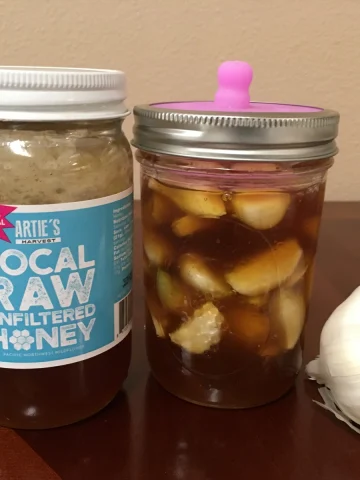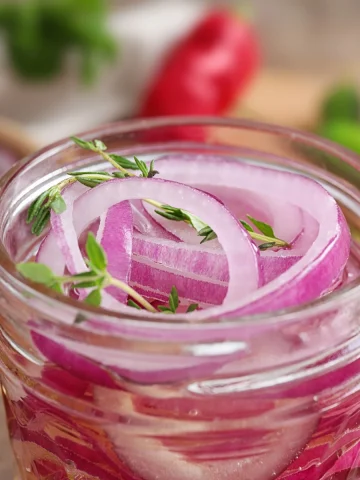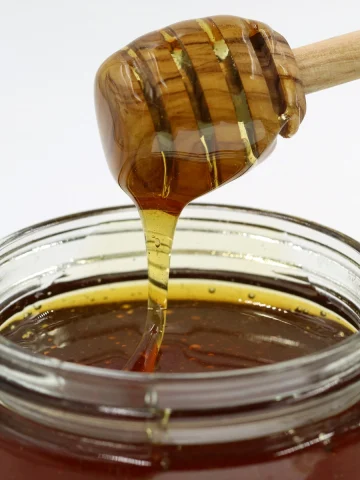Fermented carrots are a super healthy and delicious recipe prepared in 20 minutes with ease! Fermented carrots are a sure way to get a healthy dose of gut-friendly probiotics with just salt, water, and little patients.
A hint of garlic and ginger makes this fermented carrots recipe addictive! This is better than ANY store-bought fermented vegetable, guaranteed.
A great way to incorporate fermented carrots into a meal is to add them to a fresh salad or a crudité tray with ranch dip. Kids will love to grab them as a quick snack.
Lacto-Fermented Carrots Make a Great Kid-friendly Snack
Want to boost your immune system, increase the nutritional content of your food, improve your digestion and mental health, and detox your body? Fermented vegetables such as carrots are for you!
Fermented carrots taste like a fresh carrots that kids may not even know they are snacking on a healthy probiotic-rich snack. When chilled, the fermented carrots are crunchy and delicious. Add them to your kid's lunch box with a little ranch dip or hummus.
Adding fermented carrots to your favorite beef stew or chicken soup recipe is another way to incorporate them into your diet. Just be sure to add them at the last minute after you've turned off the heat because cooking destroys the gut-healthy probiotic bacteria in any fermented food.
Fermented carrots, sauerkraut, kimchi, yogurt, and beet kvass are all popular foods packed with gut-friendly lactobacillus bacteria (a.k.a. probiotics) produced during fermentation. They are widely known to have many health benefits, such as improved digestion, enhanced immune system, and better brain function, to name a few.
Make this next: Lacto-fermented Salsa, Fermented Ketchup
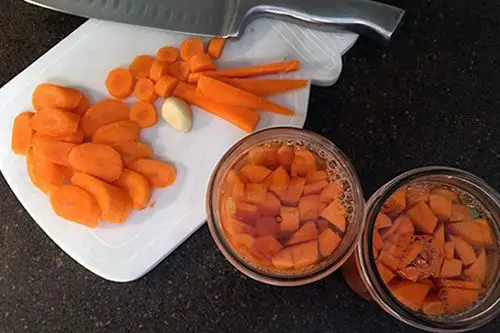
Fermenting Carrots Increases the Nutritional Value
The Lactic-acid fermentation process increases the nutritional value of the vegetables by enhancing the levels of enzymes, vitamins, and minerals.
Fermentation of Vegetables Helps Aid Digestion
Fermented foods are easier to digest than raw or cooked vegetables because the fermentation breaks down hard-to-digest cellulose and makes it easier for our digestive system to process the food.
The Fermentation Process Kills Off E.coli Bacteria
How often do we hear about an outbreak of E.coli bacteria in mass-produced vegetables?
Pretty regularly now, right?
The lactic acid produced during the fermentation kills off the E.coli bacteria. The E.coli bacteria can't survive in the acidic environment of fermentation.
Similar Recipes from Fermenters Kitchen: Fermented Curtido
How To Prevent Mushy Fermented Vegetables
Sometimes a batch of fermented vegetables might be a little mushy. This has happened to me a few times, and I was disappointed when I had to throw out a whole batch of my favorite fermented vegetables.
However, I found that it can be prevented by adding tannins to my fermented vegetable recipes. Bay leaves, grape leaves, and even a tea bag all provide a great source of tannins to help prevent a mushy outcome. Please read my post, 11 Natural Sources of Tannins for Crunchy Fermented Pickles, to learn more about how tannins help keep veggies crunchy.
The Process of Fermenting Carrots is Simple
Fermented foods go through a rather simple process of combining salted water with fresh vegetables and letting them sit for a few weeks. The lactic acid bacteria on the food surface multiply and flourish, creating an acidic environment that prevents spoilage or rot.
The vegetables must be kept below the brine to create an anaerobic environment where lactic acid bacteria will thrive. The magic all happens below the brine. I use these fermentation weights made by Siliware. You can buy them on Amazon here.
If you don't have any fermentation weights, try placing a few cabbage leaves on top of the vegetable to hold it below the brine. For more ideas on keeping veggies below the brine, check out my article, Fermentation Weights: How to keep veggies submerged.
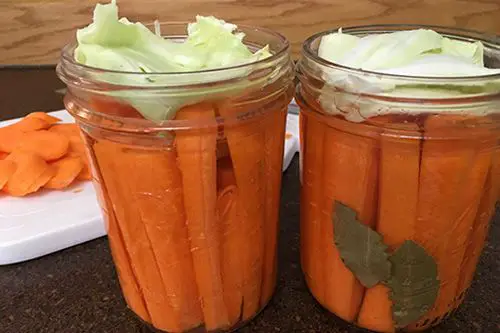
Easy Lacto-Fermented Carrots Recipe
Add these ingredients to your fermented carrots recipe: onions, garlic, ginger, bay leaves, dill leaves, or other herbs to the jar as you pack in the carrot pieces. For a spicy variation, add 1 or 2 diced jalapenos or habaneros to the jar.
Use a combination of white, purple, and orange carrots for a healthy and bright snack.
Carrots taste great with daikon radishes and apples too.
INGREDIENTS
- 2 pounds carrots, sliced into sticks, coins, or shredded
- 4 cups unchlorinated water
- 3 tablespoons Pink Himalayan sea salt
- 1 teaspoon cracked black peppercorns
- 1 sprig of fresh thyme or your favorite spices
- 2 bay leaves
- 1 clove of garlic, finely chopped
- 1 teaspoon fresh ginger, finely chopped
- 1 jalapeno chopped (optional)
DIRECTIONS
- Start by stirring the pink Himalayan sea salt and 2 cups of warm water until the salt is completely dissolved. Wait for the brine to cool completely before the next step.
- Place the garlic, ginger and any other optional spices in the jar
- Add the carrots, packing them as tight as possible, leaving about 1 inch of head space at the top.
- Pour the cooled salt water brine over the carrots and cover completely.
- Place a fermentation weight on top to hold the carrots below the brine. Here are some ideas on how to keep veggies submerged below the brine.
- Put on the lid and leave it at room temperature but out of direct sunlight.
- Store the jars at room temperature for at least 10 - 20 days, depending on the taste you would like to achieve. Hotter temperatures mean faster ferment time, and cold weather is slower. It pays to be patient because the longer it sits, the more flavor will develop.
- Remember to burp the jar daily to release carbon dioxide and add extra brine if needed.
- You can open and taste along the way until you are satisfied. I ferment mine for at least a week, which is my family's favorite flavor.
- When done, move it to the refrigerator for storage. The fermented carrots will keep for up to a year, though they lose color as the months go on.

Lacto-Fermented Carrots
Notes
Try adding any of these ingredients to your fermented carrots recipe: onions, garlic, ginger, bay leaves, dill leaves or other herbs to the jar as you pack in the carrot pieces. For a spicy variation, add 1 or 2 diced jalapenos or habaneros to the jar.
Use a combination of white, purple, and orange carrots for a healthy and bright snack.
Carrots also taste great with daikon radishes and apples too.
Ingredients
- 2 pounds carrots, sliced into sticks, coins, or shredded
- 4 cups unchlorinated filtered water
- 3 tablespoons pink Himalayan sea salt or another quality kosher salt
- 1 teaspoon cracked black peppercorns
- 1 sprig of fresh thyme or your favorite spice
- 2 bay leaves
- 1 clove of garlic, finely chopped
- 1 teaspoon fresh ginger, finely chopped
- 1 jalapeno chopped (optional)
Instructions
- Start by stirring together the pink Himalayan sea salt and 2-cups warm water until the salt is completely dissolved. Wait for the brine to cool completely before the next step.
- Place the garlic, ginger and any other optional spices in the jar
- Add the carrots, packing them in as tight as you can, leaving about 1 inch of head-space at the top.
- Pour the cooled salt water brine over the carrots and cover completely.
- If you have glass fermentation weights, place them on top of the carrots.
- Place a fermentation weight on top to hold the carrots below the brine.
- Store the jars at room temperature for at least 10 – 20 days depending on the taste you would like to achieve. It pays to be patient because the longer it sits, the more flavor will develop.
- Remember to burp the jar every day to release carbon dioxide and add extra brine if needed.
- You can open and taste along the way until you are satisfied. I ferment mine for at least a week, and that is the flavor my family enjoys the most. Keep in mind that if you live in a warmer climate, the ferment might not need as much time.
- When done move to the refrigerator for storage. The fermented carrots will keep for up to a year, though they lose color as the months go on.
Fermented foods are more popular than ever, and you can now buy them at many grocery stores and even online. Find out which brands have the probiotics and gut-healthy bacteria your body needs in my posts:
- Which Brands of Sauerkraut have Probiotics
- Best Brands of Pickles with Probiotics
- 11 Types of Cheeses that have Probiotics
- Where to Find Kimchi in the Grocery store
- Where To Buy Miso Paste
RELATED FERMENTATION GUIDES
Now that you’ve learned how to make fermented carrots, here are a few things that you might find interesting…



